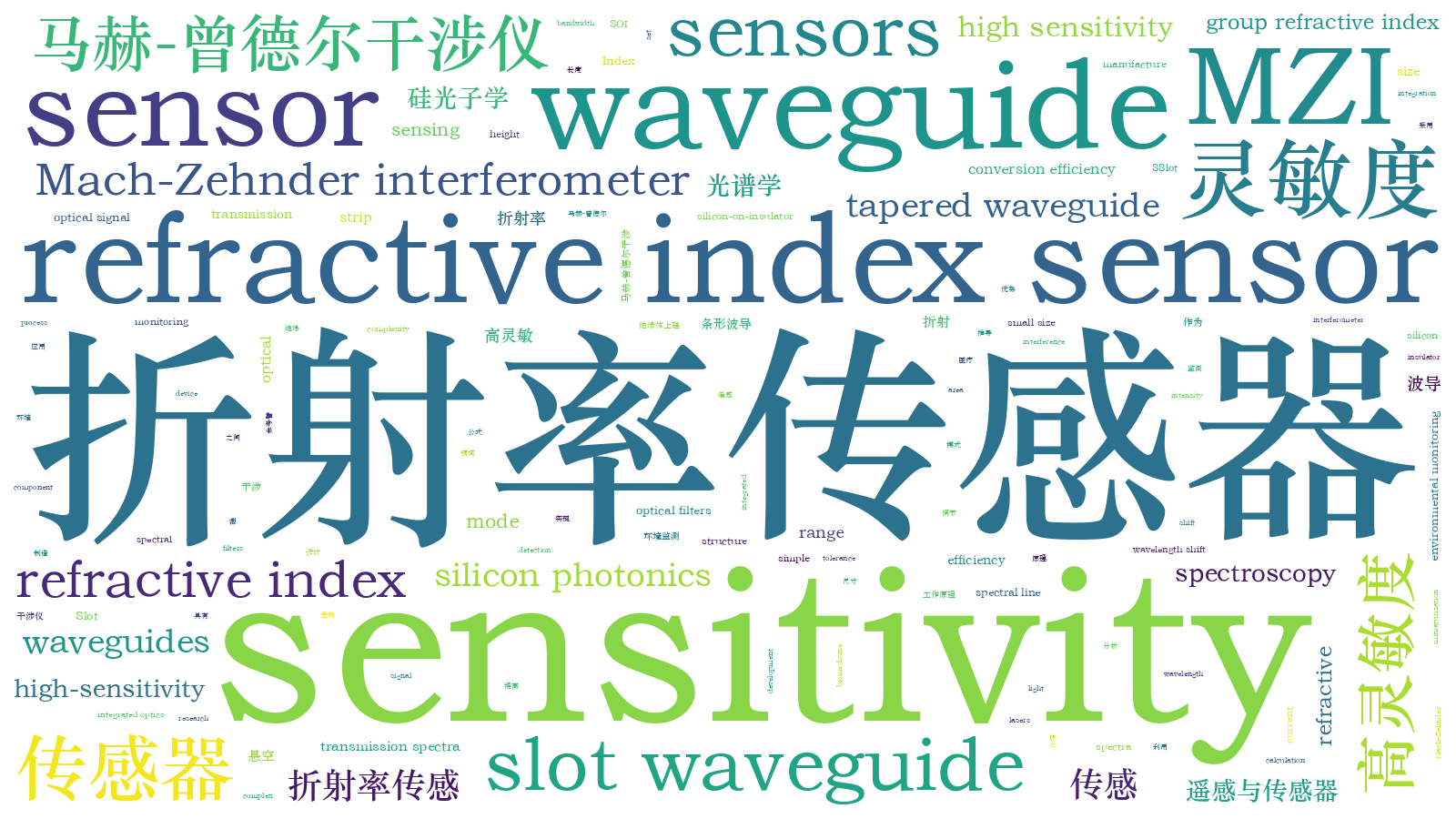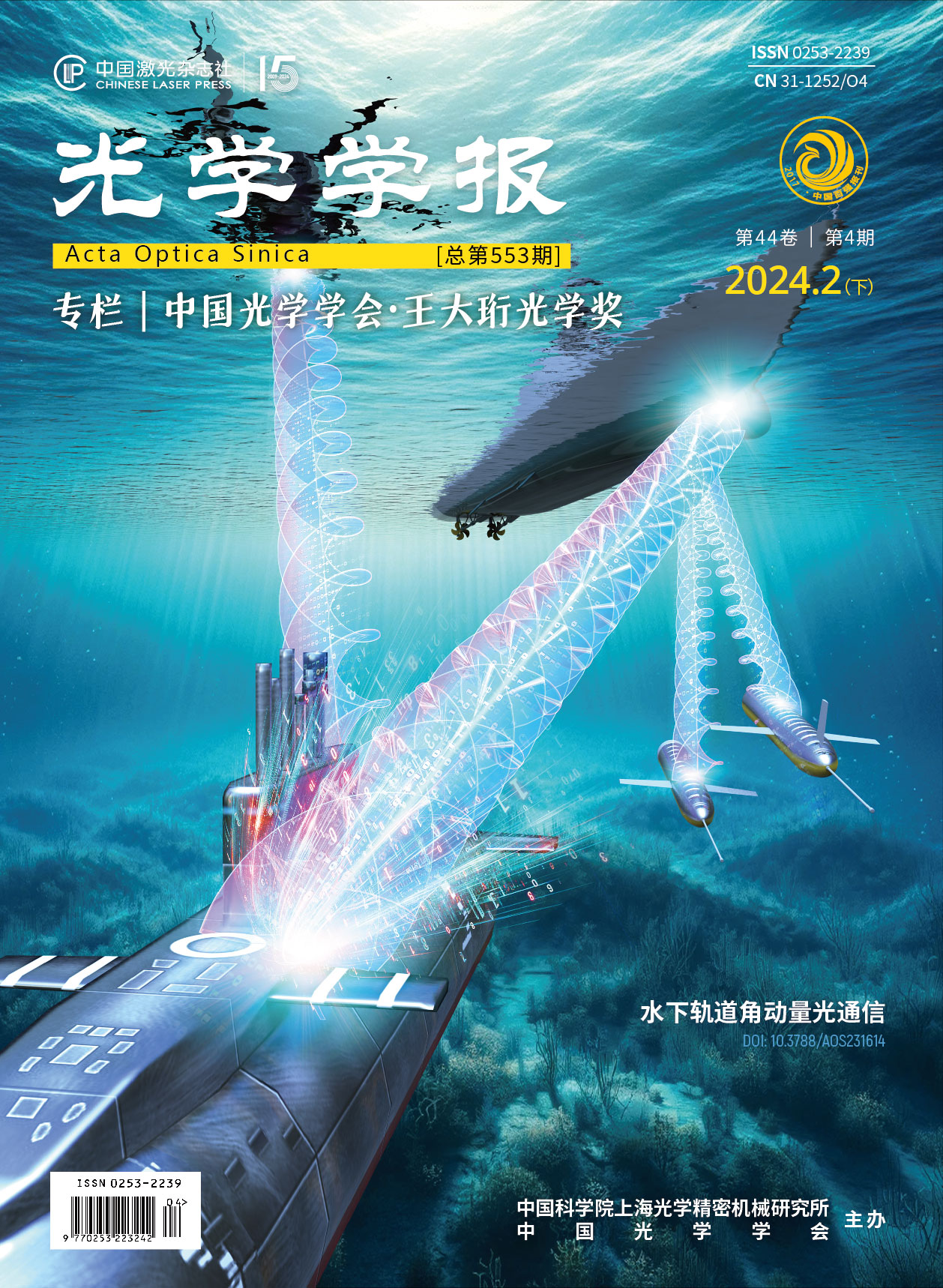基于悬空槽波导的高灵敏度折射率传感器
High-sensitivity, miniaturization, and integration sensors are still in great demand in medical detection, environmental monitoring, and other fields. One of the hot issues in the current research on sensors is to improve the sensitivity and reduce the size of sensors. Mach-Zehnder interferometer (MZI) is an important part of integrated optics, which is widely used in optical filters, optical lasers, optical sensors, and other fields. The refractive index sensor based on MZI has been widely utilized in sensing according to its advantages of simple structure, convenient manufacture, and large process tolerance. In general, MZI-based sensors implement sensing by detecting the variety of interference signals between the reference arm and the sensing arm. The proposed sensor schemes based on MZI usually have large sizes and complex structures. Therefore, the study of small-size and high-sensitivity MZI sensors is very suitable for the current development needs.
To improve the sensitivity of the sensor without increasing the complexity, we choose to add a new type of waveguide to the MZI-based sensor. The sensitivity of the MZI-based sensor is mainly determined by the difference in the length of the two MZI arms and the group refractive index of the optical signal transmitted in the waveguide. In traditional MZI-based sensor schemes, the light transmits in the same mode in the sensing arm and the reference arm, so the group refractive index difference is limited. To solve this problem, we transmit different modes on different MZI arms to obtain ultra-sensitive refractive index sensors. It is found that the sensitivity of a sensor can be improved effectively by increasing the intensity and the contact area between the waveguide and analyte. Therefore, we emit suspended slot mode into the sensing arm, launch TE0 mode into the reference arm, and adjust the length of both arms to maximize the sensitivity of the sensor.
According to formula (13), the sensitivity of the sensor is mainly determined by the waveguide sensitivity (SW) and the device sensitivity (S1). The magnitudes of S1 and SW are dependent on both the length of the two arms of the MZI and the waveguide structure. The slot gap (g)is assumed as 0.1 μm, the height of silicon (H) as 0.22 μm, and the hanging height (d) as 1 μm. According to the calculations, it is shown that within the range of 0.4-0.5 μm, the SW of the strip waveguide decreases as the width (Ws) of the strip waveguide increases. The SW of the slot waveguide increases as the waveguide width (Wslot) increases within the range of 0.25-0.26 μm, and the SW of the slot waveguide decreases as the Wslot increases within the range of 0.26-0.5 μm. SW
We propose a refractive index sensor with high sensitivity, utilizing an MZI based on silicon-on-insulator (SOI). The transmission and sensitivity formulas of the sensor are derived and analyzed. The structures of different waveguides are compared and analyzed, and it is found that the suspended slot waveguide outperforms the other two waveguides. Thus, the strip waveguide is selected as the reference arm and the suspended slot waveguide is selected as the sensing arm in the MZI sensor. Then, we conduct tests on the conversion efficiency between the TE0 mode and the slot mode in the sensor. After optimizing the length and width of the tapered waveguide, we can achieve a conversion efficiency of 97.3%. Finally, we optimize the arm length of the MZI and change the refractive index of the analyte region to obtain different transmission spectra. By detecting the wavelength shift between different transmission spectra, the sensitivity of the sensor is calculated by the formula to reach 9.824×104 nm/RIU. Our scheme also has the advantages of small size and simple manufacture and can be widely applied in biomedicine, environmental monitoring, and other fields.
1 引言
万物互联的发展使得越来越多的设备被连入网络,社会已经进入信息智能时代。计算机技术、通信技术和传感技术作为信息技术的三大支柱,代表了信息化、智能化程度。与计算机技术、通信技术相比,传感技术发展相对缓慢,为实现信息化、智能化,传感技术亟待研究和提升。在诸多传感器中,折射率传感器[1-4]因被广泛应用于污水检测、气体检测、化学分析、环境监测等生物、化学、医疗、环保领域[5-7],引起众多研究者的兴趣。随着光子集成技术的发展,越来越多的光子微型器件用于计算、通信、信号处理,采用集成材料实现光学折射率传感器已成为传感器领域的又一研究热点。常见的集成光学传感器通常采用Ⅲ-Ⅴ族半导体材料(如InP、InGaAsP等化合物型半导体材料)、Si材料、Si3N4材料和高分子聚合物材料等实现,具有体积小、损耗低、不易受环境干扰的优点。而采用Si材料实现的传感芯片因其与互补金属氧化物半导体(CMOS)工艺兼容的优势,更便于与传感系统的其他模块(如光源、调制模块、信号处理等)集成,因此具有重要的研究价值。
目前研究已经报道了多种基于硅基集成光波导结构的折射率传感器方案,大致可以分为如下几类:马赫-曾德尔干涉仪(MZI)型折射率传感器[8-11]、亚波长光栅型折射率传感器[12-13]、多模干涉耦合型折射率传感器[14]和微环谐振器型折射率传感器[15-16]。其中MZI型折射率传感器因其对分析物折射率的微小变化高度敏感,已成为应用广泛、常见的折射率传感器类型之一。近年来,随着硅基集成技术的提高,其他微纳结构与MZI相结合的传感器方案不断涌现。2014年浙江大学何建军团队[17]提出了一种使用游标效应的、基于级联微环和MZI的高灵敏度光学生物传感器,其灵敏度高达21500 nm/RIU。但是,该传感器方案中MZI的两臂长达5400 μm和5150 μm,同时带有级联微环,导致传感器尺寸较大;并且游标效应产生的包络波形检测难度大,容易出现误差。2021年中国地质大学吴志超团队[18]提出了一种基于亚波长光栅的非对称MZI传感器,其灵敏度达到了40960 nm/RIU,检测限为4.88×10-7 RIU。该方案利用亚波长光栅Bloch模式和条型波导TE0模式的干涉实现凹陷峰,再通过检测输出光谱主瓣两侧凹陷峰的位移,实现折射率传感,其灵敏度是检测单边凹陷峰位移的两倍。但亚波长光栅结构复杂、工艺容差小,难以实现大规模集成。此外,近几年来,槽波导结构逐渐受到研究者们的青睐,槽波导结构将光场约束在槽中,相较于普通条形波导,包层分析物与光场的相互作用更强。2020年印度科学学院的Selvaraja团队[19]提出一种微环与槽波导结合的液体传感器,其灵敏度达到476 nm/RIU。2020年萨马拉国立研究大学的Butt团队[20]提出一种基于亚波长光栅双槽波导的跑道微环传感器,其灵敏度达到1000 nm/RIU。该方案采用的亚波长光栅双槽波导结构增强了光场与分析物之间的相互作用,其灵敏度约为基于普通槽波导微环结构的传感器的2.5倍。2021年美国开罗大学李勋团队[21]提出将定向耦合器(DC)两端连接形成回环并与MZI和槽波导结合的一种气体传感器方案。该方案采用的回环结构能有效减小器件的尺寸,该传感器的面积仅为7.08×10-3 mm2,但其灵敏度较低,仅为1070 nm/RIU。
为了实现尺寸小、结构简单的高灵敏度折射率传感器,本文提出一种基于悬空槽(SSlot)波导的高灵敏度折射率传感器,该方案采用MZI结构,其中:MZI的一臂采用条形波导作为参考臂,传输TE0模式;MZI的另一臂采用SSlot波导作为传感臂,传输Slot模式。利用两种不同模式间传播常数的差异,在仅6.2×10-2 mm2尺寸中实现了9.824×104 nm/RIU的高灵敏度。此外,该传感器还具有结构简单、易于制备等优势。
2 基于SSlot波导的高灵敏度折射率传感器的工作原理
基于SSlot波导的高灵敏度折射率传感器采用上硅层厚度为220 nm、掩埋层厚度为2 μm的绝缘体上硅(SOI)结构,其结构示意图如

图 1. 基于SSlot波导的高灵敏度折射率传感器的结构示意图。(a)三维结构;(b)俯视图及相关结构参数
Fig. 1. Schematic diagram of high-sensitivity refractive index sensor based on SSlot waveguide. (a) Three-dimensional view; (b) top view and related structure parameters
MZI的一臂采用条形波导作为参考臂,而另一条臂采用SSlot波导作为传感臂。光信号从左端口输入,经过Y分支后,分为两部分,上部分光通过参考臂以TE0模式直接输出,下部分光则先经过1×2 MMI模式转换器,将TE0模式转换为Slot模式,再通过SSlot波导结构的传感臂,最后经2×1 MMI模式转换器转换回TE0模式,其在输出端与参考臂输出光发生干涉。利用两臂中传输的不同模式,可以在有限臂长的前提下,使传感器获得超高灵敏度。其中波导厚度H=0.22 µm,宽度W=0.5 μm。波导悬空高度为d,1×2 MMI多模波导的长度和宽度分别为Lm和Wm,锥形波导的长度和宽度分别为Ltaper和Wtaper,槽间距为g。SSlot波导的长度和宽度分别为L2(取悬空槽波导中间长度)和WSSlot,参考臂的长度为L1。根据以往制备硅基器件的经验,将连接波导的长度L0设置为5 µm,Y分支的半径r1设置为23 µm。

图 2. 耦合光栅结构示意图。(a)三维结构;(b)俯视图及相关结构参数
Fig. 2. Schematic diagram of coupling grating. (a) Three-dimensional structure; (b) top view and related structure parameters
该方案中存在SSlot波导,因此在常规硅基芯片制备工艺基础上还需要增加制备悬空波导的流程。芯片制备工艺流程可分为三个阶段:波导制备阶段、耦合光栅制备阶段和悬空波导制备阶段。波导制备流程示意图如
假设输入传感器的光场强度为Ein,经Y分支后分别进入两分支波导的光场为E1和E2,经过参考臂和传感臂后的光场为E
式中:Δφ表示两臂之间的相位差;η1和η2分别是参考臂和传感臂的损耗系数;neff1和neff2分别是参考臂和传感臂的波导有效折射率;ϕ为传感臂模式转换器引起的相位差;λ为输入光信号波长。则最终输出光场Eout可表示为
MZI的透射率T可以表示为
由
群折射率ng可以表示为
结合
式中:ng1、ng2分别为参考臂和传感臂的波导群折射率。引入器件敏感度S1,其表达式为
当ng1L1/L2-ng2-λ2Δϕ/(2πL2Δλ)趋于0时,S1趋于无穷大。为了寻找ng1L1/L-ng2-λ2Δϕ/(2πL2Δλ)趋于0时的波长,构建了K的表达式:
K代表了MZI上下两臂之间的相位差对于波长的导数。K=0处对应的波长就是ng1L1/L2-ng2-λ2Δϕ/(2πL2Δλ)趋于0的位置。再将传感臂波导的有效折射率neff2对待测分析物折射率n的偏导定义为波导敏感度SW[24],即
根据介电波导的变分方程,SW可以表示为
式中:n0为固定分析物的折射率;Z0为真空波阻抗;
由
3 基于SSlot波导的高灵敏度折射率传感器的结构优化
由上述理论分析可知,该折射率传感器可通过设计传感臂结构获得高SW值,并通过调节ng2、ng1、L1、L2等参数获得高S1值,从而实现高灵敏度。为了进一步提升传感器的性能,采用商用光学仿真平台Lumerical对该结构进行优化仿真。
图

图 4. 条形波导、Slot波导和SSlot波导的结构示意图及模场图。(a)(b)条形波导;(c)(d)Slot波导;(e)(f)SSlot波导
Fig. 4. Schematic diagrams and mode field diagrams of strip waveguide, Slot waveguide, and SSlot waveguide. (a)(b) Strip waveguides; (c)(d) Slot waveguides; (e)(f) SSlot waveguides
表 1. 100%体积分数下的不同气体折射率
Table 1. Refractive index of different gas under 100% volume fraction
|
表 2. 不同传感器的性能比较
Table 2. Comparison of performance of different schemes
|
首先分析波导宽度对SW的影响,在固定波长λ0=1550 nm时,Ws、WSlot和WSSlot在0.2~0.5 µm间变化(假设此时g=0.1 μm,H=0.22 μm,d=1 μm),可得

图 5. 条形波导、Slot波导和SSlot波导中SW随波导宽度的变化情况
Fig. 5. SW varies with widths of waveguides in strip waveguide, Slot waveguide, and SSlot waveguide
然后分析g对SW的影响,假设WSSlot=0.24 µm,可得如

图 6. SSlot波导中SW随g和d的变化情况。(a)g;(b)d
Fig. 6. SW varies with g and d in SSlot waveguide. (a) g; (b) d
由于Slot模式与TE0模式不匹配,因此直接连接条形波导和SSlot波导会带来极大的损耗。为了解决这个问题,传感臂中采用了一种1×2 MMI模式转换器。在调研了多种模式转换方案后[21,25-28],本文在文献[21]中的模式转换器基础上进行了优化设计。该模式转换器实现模式转换的示意图如

图 7. 模式转换器结构、模场分布图,以及转换效率随锥形波导长度和宽度的变化情况。(a)结构图和模场分布图;(b)转换效率
Fig. 7. Diagrams of mode converter and mode field distribution, and conversion efficiency varying with length and width of tapered waveguide. (a) Structure and model field diagrams; (b) conversion efficiency
参考臂条形波导与模式转换器之间存在一定的相位差,通过计算得到如

图 8. 条形波导与模式转换器之间的相位差ϕ
Fig. 8. Phase difference ϕ between strip waveguide and mode converter
由

图 9. 折射率传感器上下两臂之间的相位差Δφ和输出功率随波长的变化情况
Fig. 9. Phase difference Δφ between upper and lower arms of refractive index sensor and output power varying with wavelength
实现基于SSlot波导的高灵敏度折射率传感器的结构设计和参数的优化后,检测了该传感器的性能。气体折射率与气体体积分数有关,混合气体折射率=目标气体折射率×目标气体体积分数+空气中折射率×(1-气体体积分数),利用该折射率公式可以得到目标气体体积分数与混合气体折射率的对应关系。CO2、NH3、CH4气体100%体积分数下的折射率如
仿真了传感区域n=1.00029(无分析物,SSlot波导被空气覆盖)到n=1.00049情况下,传感器的传输谱线随折射率的变化曲线,其结果如

图 10. 不同折射率下传感器的传输谱
Fig. 10. Transmission spectra of sensor under different refractive index

图 11. 波长偏移量与折射率的变化关系
Fig. 11. Relationship between wavelength offset and refractive index change
为了分析本文提出的折射率传感器的性能,将该方案与以往的几种MZI结构传感器方案的性能进行了比较,其结果如
4 结论
提出了一种基于SSlot波导的高灵敏度折射率传感器,通过合理设计SSlot波导结构和MZI两臂的长度,最终实现了9.824×104 nm/RIU的超高灵敏度。该折射率传感器的尺寸仅为6.2×10-2 mm2,远低于同类型高灵敏度传感器。除此之外,该折射率传感器还具有结构简单、易于制备等优势,能满足CO2、NH3、CH4等气体浓度检测,适用于生物医疗、环境监测、灾难预警等多个领域。
[1] 贾磊, 葛益娴, 芮菲, 等. 温度自补偿的级联式光纤表面等离子体共振折射率传感器[J]. 光学学报, 2023, 43(13): 1306002.
[2] Yan R Q, Wang T, Yue X Z, et al. Highly sensitive plasmonic nanorod hyperbolic metamaterial biosensor[J]. Photonics Research, 2021, 10(1): 84.
[3] 陈颖, 张敏, 丁志欣, 等. 基于全介质超表面的微流体折射率传感器[J]. 中国激光, 2022, 49(6): 0613001.
[4] 刘春娟, 王嘉伟, 吴小所, 等. 一种光栅辅助狭缝微环谐振器的传感特性[J]. 光学学报, 2022, 42(16): 1613001.
[5] Viphavakit C, Komodromos M, Themistos C, et al. Optimization of a horizontal slot waveguide biosensor to detect DNA hybridization[J]. Applied Optics, 2015, 54(15): 4881-4888.
[6] Lo S M, Hu S R, Gaur G, et al. Photonic crystal microring resonator for label-free biosensing[J]. Optics Express, 2017, 25(6): 7046-7054.
[7] El Shamy R S, Swillam M A, Khalil D A. Mid infrared integrated MZI gas sensor using suspended silicon waveguide[J]. Journal of Lightwave Technology, 2019, 37(17): 4394-4400.
[8] Ding Z Q, Dai D X, Shi Y C. Ultra-sensitive silicon temperature sensor based on cascaded Mach-Zehnder interferometers[J]. Optics Letters, 2021, 46(11): 2787-2790.
[9] Zhang Y, Zou J, Cao Z, et al. Temperature-insensitive waveguide sensor using a ring cascaded with a Mach-Zehnder interferometer[J]. Optics Letters, 2019, 44(2): 299-302.
[10] Ding Z Q, Shi Y C. Demonstration of an ultra-sensitive temperature sensor using an asymmetric Mach-Zehnder interferometer[J]. IEEE Photonics Journal, 2021, 13(4): 6800505.
[11] Troia B, De Leonardis F, Passaro V M N. Cascaded ring resonator and Mach-Zehnder interferometer with a Sagnac loop for Vernier-effect refractive index sensing[J]. Sensors and Actuators B: Chemical, 2017, 240: 76-89.
[12] Huang L J, Yan H, Xiang L, et al. Subwavelength racetrack resonators with enhanced critically coupled tolerance for on-chip sensing[J]. IEEE Access, 2021, 9: 23424-23431.
[13] Luan E, Yun H, Laplatine L, et al. Enhanced sensitivity of subwavelength multibox waveguide microring resonator label-free biosensors[J]. IEEE Journal of Selected Topics in Quantum Electronics, 2018, 25(3): 1-11.
[14] Huang T Y, Xu G Z, Tu X, et al. Design of highly sensitive interferometric sensors based on subwavelength grating waveguides operating at the dispersion turning point[J]. Journal of the Optical Society of America B, 2021, 38(9): 2680-2686.
[15] Liu L, Hu Z H, Ye M Y, et al. On-chip refractive index sensor with ultra-high sensitivity based on sub-wavelength grating racetrack microring resonators and Vernier effect[J]. IEEE Photonics Journal, 2022, 14(5): 6849007.
[16] Fu P H, Chiang T Y, Cheng N C, et al. Microring resonator composed of vertical slot waveguides with minimum polarization mode dispersion over a wide spectral range[J]. Applied Optics, 2016, 55(13): 3626-3631.
[17] Jiang X X, Chen Y Q, Yu F, et al. High-sensitivity optical biosensor based on cascaded Mach-Zehnder interferometer and ring resonator using Vernier effect[J]. Optics Letters, 2014, 39(22): 6363-6366.
[18] Zhang G S, Huang T Y, Wu Z C, et al. Design of an on-chip sensor operating near the dispersion turning point with ultrahigh sensitivity[J]. Journal of the Optical Society of America B, 2021, 38(9): 2786-2791.
[19] Mere V, Muthuganesan H, Kar Y, et al. On-chip chemical sensing using slot-waveguide-based ring resonator[J]. IEEE Sensors Journal, 2020, 20(11): 5970-5975.
[20] Kazanskiy N L, Khonina S N, Ali Butt M. Subwavelength grating double slot waveguide racetrack ring resonator for refractive index sensing application[J]. Sensors, 2020, 20(12): 3416.
[21] El Shamy R S, Swillam M A, Elrayany M M, et al. Compact gas sensor using silicon-on-insulator loop-terminated Mach-Zehnder interferometer[J]. Photonics, 2021, 9(1): 8.
[22] Liao S S, Zhang T T, Bao H, et al. On-chip fano-like resonator with a high slope and low-complexity fabrication processing[J]. IEEE Photonics Journal, 2022, 14(1): 7809908.
[23] Xie Y W, Zhang M, Dai D X. Design rule of Mach-Zehnder interferometer sensors for ultra-high sensitivity[J]. Sensors, 2020, 20(9): 2640.
[24] Dell'Olio F, Passaro V M. Optical sensing by optimized silicon slot waveguides[J]. Optics Express, 2007, 15(8): 4977-4993.
[25] Wang Z C, Zhu N, Tang Y B, et al. Ultracompact low-loss coupler between strip and slot waveguides[J]. Optics Letters, 2009, 34(10): 1498-1500.
[26] Palmer R, Alloatti L, Korn D, et al. Low-loss silicon strip-to-slot mode converters[J]. IEEE Photonics Journal, 2013, 5(1): 2200409.
[27] Zhang H J, Zhang J, Chen S Y, et al. CMOS-compatible fabrication of silicon-based sub-100-nm slot waveguide with efficient channel-slot coupler[J]. IEEE Photonics Technology Letters, 2012, 24(1): 10-12.
[28] Deng Q Z, Yan Q J, Liu L, et al. Robust polarization-insensitive strip-slot waveguide mode converter based on symmetric multimode interference[J]. Optics Express, 2016, 24(7): 7347-7355.
[29] Sun X, Dai D X, Thylén L, et al. High-sensitivity liquid refractive-index sensor based on a Mach-Zehnder interferometer with a double-slot hybrid plasmonic waveguide[J]. Optics Express, 2015, 23(20): 25688-25699.
廖莎莎, 赵帅, 张伍浩, 张艺达, 唐亮. 基于悬空槽波导的高灵敏度折射率传感器[J]. 光学学报, 2024, 44(4): 0428001. Shasha Liao, Shuai Zhao, Wuhao Zhang, Yida Zhang, Liang Tang. High-Sensitivity Refractive Index Sensor Based on Suspended Slot Waveguide[J]. Acta Optica Sinica, 2024, 44(4): 0428001.







